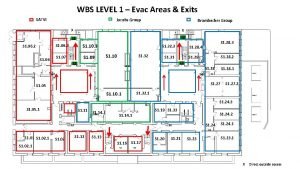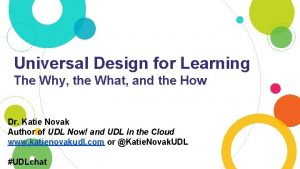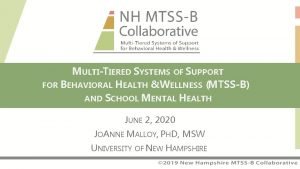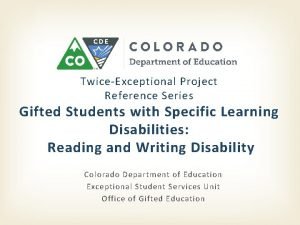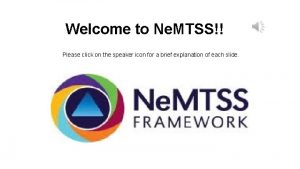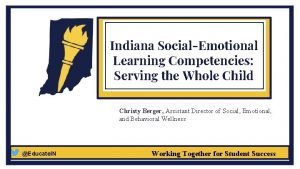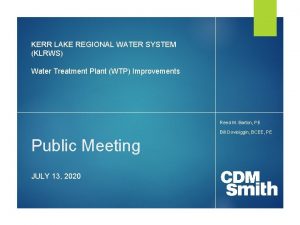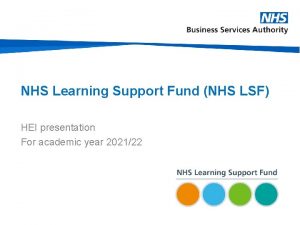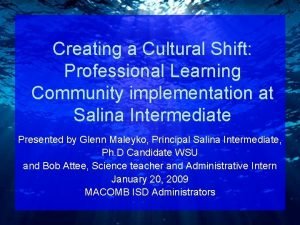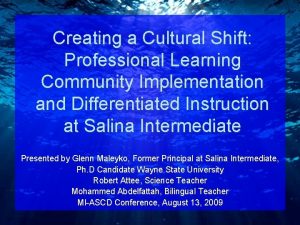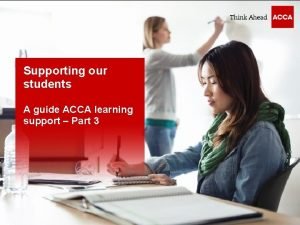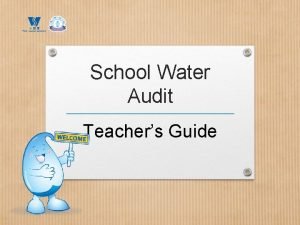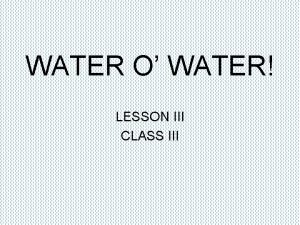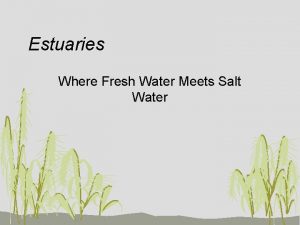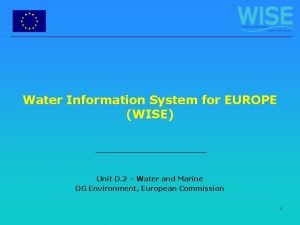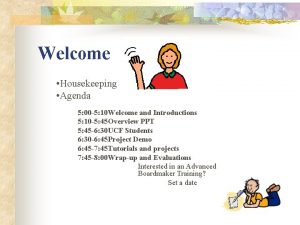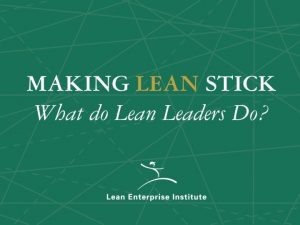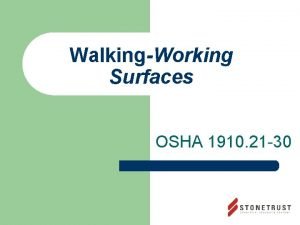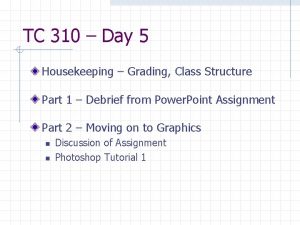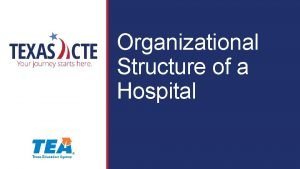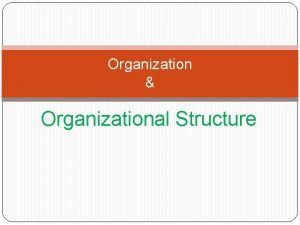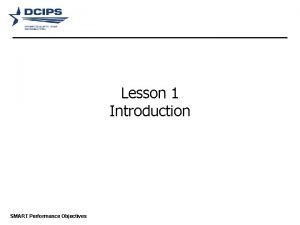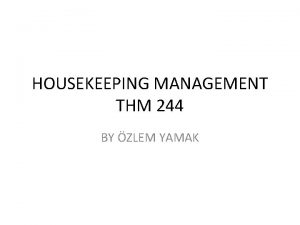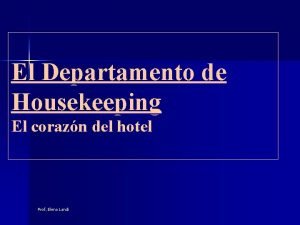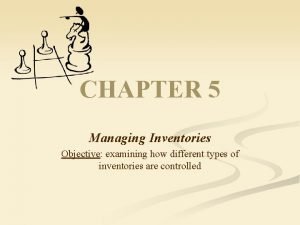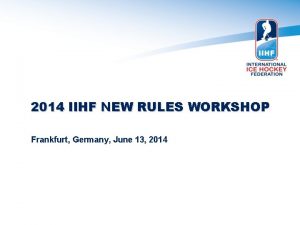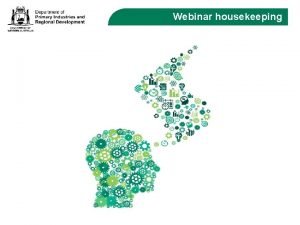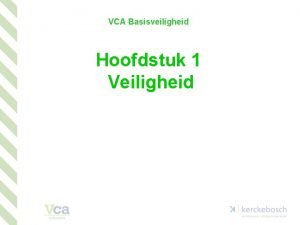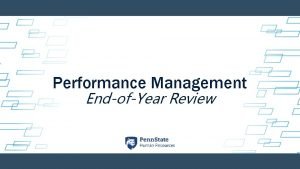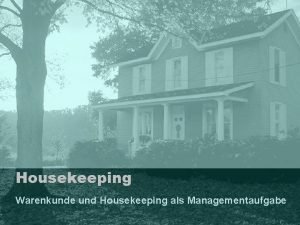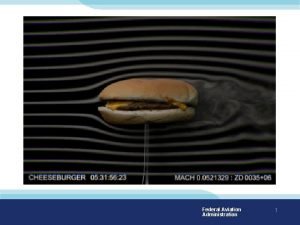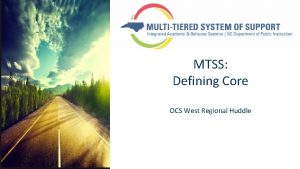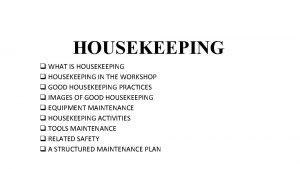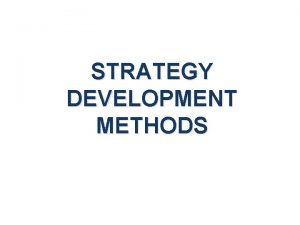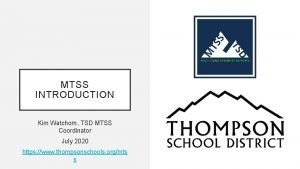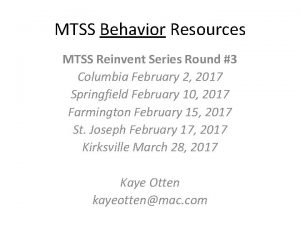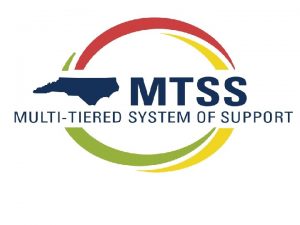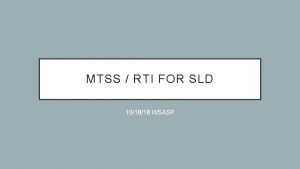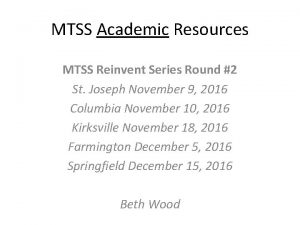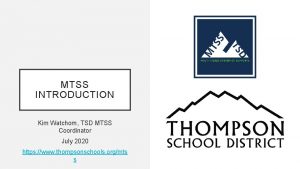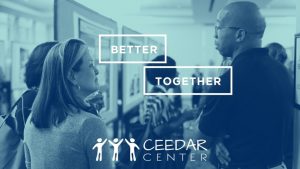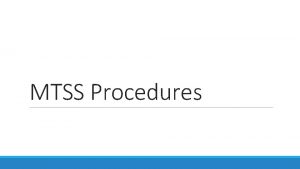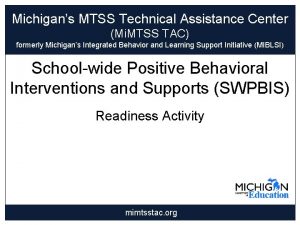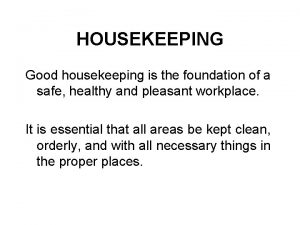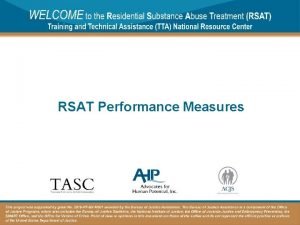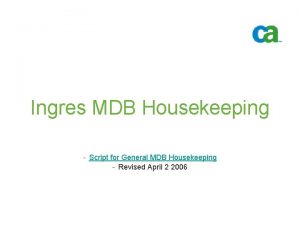MTSS REGIONAL LEARNING COMMUNITY HOUSEKEEPING Exits Restrooms Water
































































- Slides: 64

MTSS REGIONAL LEARNING COMMUNITY

HOUSEKEEPING ● Exits ● Restrooms ● Water ● Snacks

MTSS RLC’s Purpose: ● ● Build a community of learning leaders to support the journey of MTSS implementation within districts throughout the CNY region Share evidence-based practices and resources to support the whole child Facilitate collaborative problem solving and create opportunities to provide and receive feedback on emerging ideas Provide opportunities to network, support each other, and build capacity to meet the diverse needs of all students

MEET THE TEAM Kim Mackey Sue Kuck District Data Coordinator Team Facilitator RLC Project Co-Lead Shelly Hilts Candace Fitzgerald Terri Clark District Data Coordinator Systems Consultant: School. Tool

AGENDA 8: 45 Event Kick off! 9: 15 Finger Lakes Community Schools Presentation -------------11: 00 -12: 30 Lunch ----------------12: 30 Data Inventory Activity 1: 00 Focus on Alignment: What’s In Your Closet? 1: 30 Breakout Sessions: Initiative Inventories & Action Planning 2: 45 Wrap-Up & Next Steps

OBJECTIVES Deepen your understanding of a comprehensive Multi-Tiered System of Supports Understand the importance of using data to make informed decisions at all tiers Explore strategies to increase coordination of partnerships to achieve meaningful support Assess your District’s current capacity and develop an action plan to strengthen your MTSS Identify common needs across the region and discuss resources for additional support

https: //www. nyscommunityschools. org/intervention-for-all-resourcepage/

Join the Conversation #CNYRICmtss @cnyric @nyscstac



NYS Community Schools Technical Assistance Centers


• Share and disseminate information more broadly Inform Network • Create new allies; find out what others think and are doing - “real world implementation” • Engage people in sharing and providing feedback on emerging ideas; create synergy across levels of implementation Collaborate Transform • shared leadership, consensus building - increase likelihood of sustainable solutions

Central/Western CS-TAC Region

CS-TAC Goals • Work with all school districts regardless if receive set-aside funds, utilize a Community School Resources Co-Ser, or identify as a community school • Build collaborative network • Resource repository on evidence based practices • Ongoing technical assistance and professional development • Increase statewide capacity to implement and assess community schools strategies

What does it look like? Community School Traditional Model ▪ Intentional school transformation strategy focused on collective participation ▪ Interconnect additional resources to develop collaborative systems ▪ Integrate learning opportunities that develop cognitive, social, emotional, physical and civic competencies ▪ Build social capital—enhance networks and relationships that support learning and create opportunities for young people ▪ Inform through shared data and team membership ▪ Periodic participation & not tied to whole school efforts ▪ Siloed, non-aligned operation of community partners and programs ▪ Added on or parallel learning opportunities beyond academics that do not align to curriculum ▪ Networks are not known or acknowledged to promote maximum collaboration ▪ Data may be collected but not shared across stakeholders & team membership may lack representation or decision making authority

Not a new Thing: • • Expanding learning opportunities Engaging families as leaders Improving access to mental health and health services Strengthening community connections Food and clothing pantry Counseling and mental health clinics Tele-health, tele-mental health & tele-psychiatry Gardens & farm to cafeteria initiatives Workforce Development Adult education School-based health clinics Dentist services Attendance initiatives After-school & summer care



Implementation Science “the use of effective interventions without implementation strategies is like serum without a syringe; the cure is available but the delivery system is not” –Fixsen, Blasé, Duda, Naoom, & Van Dyke, 2010


An Integrated Approach “A framework is like a toothbrush…. everyone has one and no one wants to use anyone else’s. ” -Eric Bruns, Ph. D University of Washington Associate Director, UW SMART Center

What’s Under Your Umbrella? MTSS-A Problem Solving/Rt. I CI 3 T Rt. IAcademic Comprehensive Student Support Systems Scientific Research Based Instruction SW-PBIS Rt. I-Behavior School Behavioral Health MIBLSI Interconnected Systems Framework MTSS-B Positive Behavior 4 Learning Adapted from G. Sugai, 2018

MTSS “integration of a number of multipletiered systems into one coherent, strategically combined system meant to address multiple domains or content areas in education” Mc. Intosh & Goodman, 2016, p. 5


MTSS & Community Schools 6 Critical Features MTSS Integrating Community Schools 1. Team based leadership & coordination 1. Community partners integrated within teams 2. Evaluation of implementation fidelity 2. Fidelity assessed regularly at school & partner 3. Tiered continuum of evidence based practices 3. Protocol for selecting EBP’s at all tiers (including agencies CBO partners) & consideration for contextual fit 4. Continuous data based progress monitoring and decision making 4. Integration of community and school data for decision making 5. Comprehensive universal screening 5. Screening informs “in, on & off” intervention 6. On-going professional development including 6. Community partners & schools attend integrated coaching with content expertise Created in partnership with Ali Hearn, Midwest PBIS decision rules including partner agency’s professional development


www. flxcommunityschools. org Joseph D. Fantigrossi, Ed. D. Jay Roscup Director of Intervention and PD Director

Welcome Back!

Student Management System (School. Tool) - Admins, Teachers, Counselors - End of Marking Period - Team Meetings Analyzing the root cause of why students are absent. Timer

Timer

Alignment

MTSS & Community Schools 6 Critical Features MTSS Community Schools 1. Team based leadership & coordination 1. Community partners integrated within teams 2. Tiered continuum of evidence based practices 2. Protocol for selecting EBP’s at all tiers (including CBO partners) & consideration for contextual fit 3. Continuous data based progress monitoring and decision making 3. Integration of community and school data for decision making 4. Comprehensive universal screening 5. Evaluation of implementation fidelity 6. On-going professional development including coaching with content expertise Created in partnership with Ali Hearn, Midwest PBIS 4. Screening informs “in, on & off” intervention decision rules including partner agency’s 5. Fidelity assessed regularly at school & partner agencies 6. Community partners & schools attend integrated professional development



Alignment & Integration • Build common language & knowledge base • Utilize initiative inventories to assist in examining: What: Who: Where: When: How: What practices are in place? Who is implementing and who has access to supports? Where is practice taking place? (district wide/bldg specific) When are we assessing? (implementation, prog. monitoring, outcomes) How is system capacity? (selection, training, coaching, data informed)

1. Identify shared, valued OUTCOMES (and measures) 2. Pick the PRACTICES that are most likely to achieve those outcomes 3. Implement the practices within SYSTEMS that maximize fidelity Mc. Intosh, 2017

Trauma Informed Strategies Discipline Handbook School Mental Health Wraparound Check & Connect Function-based Support Responsive Classroom Restorative Practices Wellness & Self-Regulation Academic & Social Emotional Behavioral Success Cognitive Behavior Counseling Check In Check Out Social Emotional Learning Specific Curriculum Dropout Prevention Bullying Prevention School Climate Initiative Cultural Responsiveness SW-PBIS Social Skills Programming MIDWEST P NETWORK B I S

MULTI-TIERED SYSTEM OF SUPPORTS FOR BEHAVIOR ~5% Trauma Informed Practices ~15% Restorative Practices Academic Intervention s Extended school day & summer programming Bullying Prevention Community Mental Health Agency ~80% of Students MIDWEST P NETWORK B I S

MIDWEST P NETWORK B I S

Updated: 12/22/2014 High Larkin High School Map of Student Support Programming Systems Team: Systems Coordinators: Administration, Academic and Behavioral Intervention Coordinators, Tier 1/2/3 Coaches Academic Intervention Coordinator: Darlea Livengood Student/Parent Ambassadors: Three to Five Representatives (need more) Behavior Intervention Coordinator: Antonio Rios Tier 3 RENEW* (Riedel/Lopez ) Melissa Nytko, Joan Riedel, Karen Lopez Level of Intensity 5 TH yr. Contracts (Rios) Tier 2 FBA/BIPS* (Coun/SPED CM) SAIG* I-CICO* Kim Kalousek – Darlea Livengood – Secondary Systems Team Prescriptive APEX AVID Required Tutoring BGC Core Curriculum* (Gartshore) Girls Mentoring (Soc. Workers) RENZ Center Alcohol/Drug Tier 1 KAGAN (Osorio) Boys and Girls Club Area of Focus - Not Fully Implemented Royal* Mentors Attendance Room (Riedel) Grief Group (Soc. Workers) Why Try? (Soc. Workers) Teen Parenting (U 46) Truancy 1 -on-1 ROYAL Power* Educ. * George Kalousek – Antonio Rios – Universal Team Academic *- meets all PBIS/RTI criteria Freshmen Transitions (Soc. Workers) CICO* (Abdic) (Counselors) After School Tutoring BGC Resource Room Drop-In Post Hospital (Soc. Workers) In School Intervention Scheduled Res. Room* Reading Classes (Osorio) Low Game Changer Mentors School Council with 9 th grade Transition team Social/Emotional/Behavioral MIDWEST P NETWORK B I S


Key Considerations § Inventories are “live” –dependent on iterative and collaborative process § Consider housing in a “shared” drive to promote access and feedback § Can be completed according to need & scale § BOCES (ISS/Program specific) § District Building § Zoom in to topical areas (SEL, Behavior, Health, Academics)





Initiative Inventory Process • Purpose-guide review of past and current initiatives to produce clear picture of initiatives, mandates & resource commitments • Results can be used to: • Explore fit of additional initiatives with current work • Guide decision making • Assist with alignment

Initiative: priority efforts, strategies, interventions, practices, or projects in which an agency is engaged in order to produce desired outcomes. *Initiatives can be in place for: Tier I: Universal (all students/clients) Tier II: Small groups with similar identified needs Tier III: Individualized

Tier 1 (100%): Universal, for all individuals, regardless of their need (Prevent a particular condition from occurring AND opportunities to optimize learning or cultivate strengths) Tier 2 (5 -15%): Selected, for those at increased risk of challenges (Additional instructional, structure or opportunities to practiceidentified through multiple measures) ***Generic, additional support provided in same way to all students-typically delivered in groups Tier 3 (1 -5%): Targeted, for those on track toward negative outcomes (Individualized plans & interventions, layered in addition to Tier 1 & 2)

Process steps: • Obtain executive leadership commitment and buy-in to the process to support intended outcomes • Develop a clear plan & coordinate the process: • Who will lead (2 -3 members): ensure execution, provide updates, confirm data used for decision making, monitor progress • Key roles needed: consider facilitation, note taking, data collection • Process for collecting info • Process for how it will be used: ID clear purpose and outcomes

Identify Intended Outcomes of the Inventory: Identifying outcomes will guide in developing effective plan to: • Complete the inventory • Maintain the information • Guide how will be used as a “way of work” Ex. Determine scale: • • Specific area (e. g. academics-literacy or social/emotional/behavioral) Building/Program Level District Regional



Inventories • Complete as much as possible for each initiative • Note who or what additional information is needed • Be sure to indicate targeted population by Tier


Initiative Inventories-Regroup • Initial thoughts? • What areas are blank? • How might you use the inventory with: • Administration • Staff • Families • How might this process build collaborative opportunities? In district? Within BOCES regions?

Action Planning

What shared work could unite us? Relationship building takes time. Shared activities make a start and lead to bigger opportunities. Activities that Might Have Value Defining a shared problem Information Exchanges Productive Inquiries Joint Events Mapping Resources Developing Shared Messages Other (Specify) For All Groups? If not for all groups, list specific groups




Thank you! tiny. cc/MTSSrocks

The Hexagon: An Exploration Tool The Hexagon can be used as a planning tool to guide selection and evaluate potential programs and practices for use.
 Victoria educational gardens
Victoria educational gardens Water and water and water water
Water and water and water water An opening on the earth's crust where lava exits
An opening on the earth's crust where lava exits Wbs level 1
Wbs level 1 This organelle controls what enters and exits the cell. *
This organelle controls what enters and exits the cell. * Mtss and udl
Mtss and udl Mtss memes
Mtss memes Mtss-b
Mtss-b Mde mtss documentation packet
Mde mtss documentation packet Mtss needs assessment
Mtss needs assessment Mtss documentation packet
Mtss documentation packet Benefits of mtss
Benefits of mtss Mtss
Mtss Mtss nebraska
Mtss nebraska Decreto 283/996
Decreto 283/996 Mtss infographic
Mtss infographic Idoe mtss
Idoe mtss Learning objectives for housekeeping
Learning objectives for housekeeping Cuadro comparativo de e-learning
Cuadro comparativo de e-learning Kerr lake regional water system
Kerr lake regional water system Nhs student learning support fund
Nhs student learning support fund Prepare to scale up in community mobilization
Prepare to scale up in community mobilization Community language learning
Community language learning Language
Language Secondlive bsc
Secondlive bsc Cultural shifts in a professional learning community
Cultural shifts in a professional learning community Cultural shifts in a professional learning community
Cultural shifts in a professional learning community Learning community acca
Learning community acca Water consumption water meter reading worksheet
Water consumption water meter reading worksheet Fresh water allowance adalah
Fresh water allowance adalah How can we reuse water for class 3
How can we reuse water for class 3 5 divided by 1/4
5 divided by 1/4 Class 8 english chapter 7 water water everywhere
Class 8 english chapter 7 water water everywhere Water exchanger
Water exchanger Fresh water meets salt water
Fresh water meets salt water Warm water rises in a lake. cold water descends.
Warm water rises in a lake. cold water descends. Clil water
Clil water The importance of water management
The importance of water management Unit 11 water water everywhere
Unit 11 water water everywhere Background color
Background color Webinar housekeeping slide
Webinar housekeeping slide Osha ladders 1910
Osha ladders 1910 Housekeeping feladata
Housekeeping feladata The role of housekeeping in hospitality operations
The role of housekeeping in hospitality operations Housekeeping monthly may 1955
Housekeeping monthly may 1955 Housekeeping monthly 13 may 1955
Housekeeping monthly 13 may 1955 Debriefing in housekeeping
Debriefing in housekeeping Request housekeeping services examples
Request housekeeping services examples Ddo housekeeping
Ddo housekeeping Housekeeping slide for presentation
Housekeeping slide for presentation Organizational structure of hospital
Organizational structure of hospital What is an organization
What is an organization Housekeeping objective
Housekeeping objective Jsa housekeeping
Jsa housekeeping Jamb in housekeeping
Jamb in housekeeping Departamento de housekeeping
Departamento de housekeeping Służba pięter stanowiska
Służba pięter stanowiska What is opl in housekeeping
What is opl in housekeeping Recycled inventories in housekeeping
Recycled inventories in housekeeping Iihf new rules
Iihf new rules Housekeeping webinar
Housekeeping webinar Wat houdt good housekeeping in vca
Wat houdt good housekeeping in vca Housekeeping productivity formula
Housekeeping productivity formula Housekeeping items meeting
Housekeeping items meeting Wäschebeschließerin definition
Wäschebeschließerin definition
